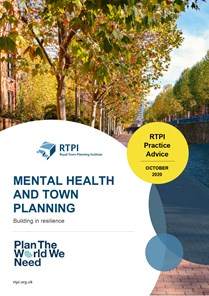 In the UK and Ireland, the rates of mental health illness are high. It is estimated that around one in four people will experience a mental health condition. This places a huge burden on individuals, their families and on society. Where someone lives can have an impact on their mental health. The quality of the wider built environment is also a determining factor for mental health, with noise, pollution levels, quality of green space, access to services and even ‘beauty’ all playing a part. Therefore, town planning decisions can have an impact on mental health. Creating an accessible, inclusive built environment that enables everyone to play an equal role in society is important in protecting and enhancing everyone’s well-being and mental health.
In the UK and Ireland, the rates of mental health illness are high. It is estimated that around one in four people will experience a mental health condition. This places a huge burden on individuals, their families and on society. Where someone lives can have an impact on their mental health. The quality of the wider built environment is also a determining factor for mental health, with noise, pollution levels, quality of green space, access to services and even ‘beauty’ all playing a part. Therefore, town planning decisions can have an impact on mental health. Creating an accessible, inclusive built environment that enables everyone to play an equal role in society is important in protecting and enhancing everyone’s well-being and mental health.
This practice note gives advice on how planners can work within the current UK planning systems and with other professionals to take account of mental health when making changes to the built environment. It summaries expert advice, outlines key planning policy, good practice and case studies. The policy context applies to England, Wales, Scotland, Northern Ireland and Ireland, but the principles of good practice apply wherever you work in the world.
Download the full report here or read it below.
For more information contact [email protected]
Please note that The RTPI runs a CPD Masterclass on ‘Planning for Public Health and Wellbeing’ each year. Please find the upcoming dates of this masterclass in the CPD Training Calendar.
If you have any question relating to CPD training, please email: [email protected]
Mental health and town planning: Building in resilience
Contents
- Introduction
- About mental health
- The built environment and mental health
- What does a place designed to promote good mental health look like?
- Planning for mental health
- Legislation and policy
- Design of health and education facilities
- Tools to integrate mental health into town planning
- Further information
1. Introduction
The UK and Ireland have high rates of mental health illness. It is estimated that around one in four people will experience a mental health condition. Mental illnesses can be more common, long lasting and impactful than many other health conditions. This places a huge burden on individuals, their families and on society. According to the mental health charity Mind, the number of people reporting mental health problems has increased in recent years[1]. Globally it is estimated that 10% of people live with a mental health disorder, around 792 million people[2].
Where someone lives can have an impact on their mental health. It is reported that the majority of people with a mental health condition have lived in housing that has made their mental health worse[3]. The quality of the wider built environment is also a determining factor for mental health, with noise, pollution levels, quality of greenspace, access to services and even ‘beauty’ all playing a part. Town planning decisions can therefore impact on mental health.
In recent years high profile media campaigns[4] have encouraged many people to become more open about their mental health, leading to improved acceptance and support within society. The Covid-19 pandemic has led to an increase in the number of people reporting a mental health condition, at a time when access to services and support has often been constrained. The longer-term impacts of the pandemic on mental health is still to be assessed.
More than 20% of the population have a disability: a physical, mobility, sensory or cognitive impairment. Many conditions co-exist, particularly in older people, and they place individuals at increased risk of developing mental health conditions. Creating an accessible, inclusive built environment that enables everyone to play an equal role in society is important in protecting and enhancing everyone’s well-being and mental health.
This practice note gives advice on how planners can work within the current UK planning systems and with other professionals to take account of mental health when making changes to the built environment. It summaries expert advice, outlines key planning policy, good practice and case studies. The policy context applies to England, Wales, Scotland, Northern Ireland and Ireland, but the principles of good practice apply wherever you work in the world.
The audience for this advice is primarily RTPI members, but it is also relevant to other built environment professionals, public health professionals, charities and local politicians.
2. About mental health
What is mental health?
The World Health Organisation (WHO) defines mental health as a state of well-being in which the individual realises their abilities, can cope with the normal stresses of life, work productively and fruitfully, and is able to contribute to their community[5]. Conversely, mental illness is an experience that interferes with day-to-day functioning[6]. Mental health can be seen as a continuum. From being healthy and happy, through to common mental disorders, to severe mental health illnesses.
Common mental health disorders include stress, depression, anxiety, panic disorder, phobias, and obsessive-compulsive disorder. Severe mental illness refers to people with psychological conditions that are often so debilitating that their ability to engage in everyday activities is severely impaired[7]. These illnesses include conditions that produce psychotic symptoms, such as schizophrenia and schizoaffective disorder, and severe forms of other disorders, such as major depression and bipolar. The mental health charity, Mind provides information on the different types of mental health conditions[8]. An individual may experience more than one mental health or physical health condition at the same time. Each person will experience mental health conditions in their own individual way.
Many mental health conditions are treatable through treatment, and psychiatric medication. Alternative therapies, such as arts and creative therapies can also be helpful. There are also self-care techniques and general lifestyle changes can help manage the symptoms of many mental health problems. They may also help prevent some problems from developing or deteriorating[9]. These techniques include improving sleep quality, physical exercise, eco-therapy and social support networks. The built environment, environmental quality, access to greenspace and connectivity can all play a part in how well an individual can participate in these self-care, preventative techniques and general well-being.
Prevalence of mental health conditions
The UK and Ireland have high rates of mental health illness. Mental ill health is the single largest cause of disability in the UK, contributing up to 22.8% of the total health burden, compared to 15.9% for cancer and 16.2% for cardiovascular disease[10]. The NHS estimates that approximately one in four people in the UK will experience a diagnosable mental health condition each year[11]. The Adult Psychiatric Morbidity Survey[12] provides data on the prevalence of both treated and untreated psychiatric disorder in the English adult population. The last survey was conducted in 2014. It found that one in six people in England were affected by a common mental health disorder at any one time. The same rates are reported for Wales[13], while the Scottish Government reports a higher figure with around one in three people estimated to be affected by mental illness in any one year[14]. The Northern Ireland Health Survey 2014/15[15] reported that 19% of individuals show signs of a possible mental health problem and according to prescribing trends; Northern Ireland has significantly higher levels of depression than the rest of the UK[16]. The situation in the Republic of Ireland is estimated at one in four people experiencing a mental health problem in their lifetime[17].
The prevalence of common mental health conditions varies between age, ethnicity, gender, sexuality, employment, deprivation, location and many other factors. For example, economically inactive and unemployed people are substantially more likely to have experienced a common mental health condition than those who are in work. People from black, Asian and minority ethnic (BAME) communities are more likely to experience a mental health condition in any given week.
Suicide rates in the UK and Ireland are also high. Registered deaths from the Office of National Statistics for England and Wales put the figure at 5,691 for 2019, which represents a significant increase in the suicide rate since 2017[18]. Three quarters of people who committed suicide were men. Northern Ireland has the highest rates of suicide in the UK[19]. Mental ill health can have a significant impact on life expectancy and is a key cause of health inequalities. Research undertaken in the UK in 2011 found that people with severe and enduring mental health problems die on average 10 years earlier than the general population[20].
Public Health England’s data dashboards[21] draw together a range of local and national data on mental health, dementia and neurology. Whilst primarily published for public health professionals they can provide valuable information for planners on prevalence rates and risk factors.
Risk factors for developing mental health conditions
A number of factors can influence an individual’s risk of developing a mental health condition These include poverty, poor housing, family conflict, unemployment, childhood adversity and chronic health problems. The risk is increased if several factors occur together, without protective factors to offset their negative impact.
Traditionally physical and mental health have been considered separately. However, the links between mental health and physical health are strong and poor physical health can lead to an increased risk of developing mental health problems. Similarly, poor mental health can have a negative impact on physical health, leading to an increased risk for some conditions[22]. It is reported that 37% of people with severe symptoms of common mental disorders also have one or more of, high blood pressure, cancer, epilepsy or asthma[23]. The Campaign to End Loneliness reports that a lack of social connections is a comparable risk factor for early death as smoking 15 cigarettes a day. It increases the likelihood of mortality by 26%, higher than other well-known risk factors such as obesity and physical inactivity. This is significant when over 9 million people in the UK identify as always or often lonely[24].
People who have a neurodivergent condition, including, autism, aspergers syndrome, dyslexia, ADHD and dyspraxia and Sensory Processing Sensitivity (SPS) are also more at risk of developing a mental health condition. Neurodiversity refers to the wide spectrum of the whole population, including people who are neuro typical, neuro divergent or neuro degenerative. In the same way, that biodiversity refers to a wide range of biological and ecological conditions, neurodiversity is the concept that these neurological differences are the result of the natural variation in the anatomy of the human brain, not that something is wrong and needs to be ‘cured’. It is estimated that at least 15% of the UK population is neuro divergent with a wide spectrum of characteristics, some of which are shared with people with neuro degenerative conditions like dementia. Many people with neuro divergent or neuro degenerative conditions find public spaces and buildings overwhelming and difficult. The location and layout of buildings inside and out can cause discomfort and stress. This is often due to how busy, noisy, bright, confusing, or over-stimulating they are. Some people with sensory disabilities including sight and hearing loss also experience this sensory overload. The RTPI practice advice, ‘Dementia and town planning’[25] gives details on how planners can create dementia friendly environments. Neurodiversity in Planning[26] is a network for neuro diverse planners and to promote good planning practice.
Where someone lives is another risk factor. People living in the most deprived areas of England were twice as likely to be referred to psychological therapies services as those living in the least deprived areas in 2017/18. They also have lower rates of recovery[27]. The mental health charity Mind surveyed 2000 people in 2017 in England and Wales, and found that 79% of people with mental health problems have lived in housing that has made their mental health worse. Of these, 70% of people reported experiencing at least one issue with the quality of their housing, such as damp, mould, threat of eviction, overcrowding and unstable tenancies[28]. Homelessness is particularly damaging; and being homeless almost trebles a young person’s chance of developing a mental health problem[29].
A 2017 survey of children and young people's mental health found that 12.8% of children between 5 and 19 had at least one mental health condition. Children whose households were receiving low-income benefits were almost twice as likely to have a mental health condition (18.2%) compared those who were not (9.8%)[30]. When taken together with the figure quoted by the Mental Health Taskforce, that half of all mental health illnesses are established by the age of 14 and 75% by age 24[31], it presents a concerning future for vulnerable parts of society.
Financial cost of poor mental health
There are significant economic costs of poor mental health. The Centre for Mental Health estimates that ill health has an economic and social cost of £119 billion a year in England, as measured in health spending, output losses and human capital[32]. Estimates by the Faculty of Public Health put the cost of mental illness for Northern Ireland at around £3 billion, Wales £7 billion and Scotland £9 billion in 2009/10[33]. It has also been estimated that optimal treatment for mental disorders will only avert 28% of the burden of mental illness, highlighting the benefits of focusing on prevention.
There are direct costs to employers from mental health conditions. The cost of sickness absence, reduced productivity and staff replacement is estimated to be £35 billion in 2017 in the UK, with the loss of 72 million working days[34]. In 2015, common mental health problems (such as anxiety, depression and stress) and more serious mental health problems were the third most important cause of sick leave[35]. Compounding these figures is the research carried out by Oxford Economics that suggests that 181,600 people cannot join the labour force because of their mental health problems[36]. An Organisation for Economic Co-operation and Development (OCED) report found mental health problems cost Ireland's economy €8.2 billion every year leading to a reduction in the country's GDP by 3%[37].
The NHS budget for mental health care in England was £12.2 billion in 2018/19, representing approximately a tenth of the total Department of Health and Social Care budget[38]. There is also a significant variation in spending levels on mental health provision across the country[39]. There are examples of a more preventative approach being taken to mental health. Public Health England launched the mental health campaign ‘Every Mind Matters’ in 2019, to support people to take action to look after their mental health and well-being by promoting a range of self-care actions[40]. Public Health Scotland also has a set of mental health and suicide prevention learning resources[41].
Covid-19 and mental health
The Covid-19 pandemic has been described as ‘the greatest public health crisis of our generation’[42]. However, the impact has not just been on the physical health of the individuals who have contracted the virus. The Centre for Mental Health estimates that because of the pandemic that at least half a million more people in the UK will experience a mental health difficulty this year[43]. The charity, Mind published the results of a survey of 16,000 respondents to understand the experiences of people with pre-existing mental health problems during the early part of the Covid-19 pandemic. It found that more than half of adults (60%) and over two thirds of young people (68%) said their mental health deteriorated during lockdown. People with mental health problems are more likely to see their mental health worsen because of coronavirus restrictions and many without previous experience of mental health problems have experienced poor mental health during lockdown[44].
Mind is among many mental health organisations to warn of the long-term effects of the Covid-19 pandemic on mental health. Key factors are the uncertainty of future outbreaks and restrictions, economic downturn and widespread job losses, time away from education for young people, changes in working patterns and increased isolation for many. The full impact may take some years to become clear. A Mental Health Foundation study found that the burden of mental distress is borne disproportionately by those with less economic security, existing mental health problems, or those from ethnic minority groups that experience structural inequalities[45].
Neighbourhood level characteristics have had an impact on vulnerability to Covid-19, in terms of access to greenspace, local amenities and services. In addition to the increased likelihood of living in overcrowded housing with poor infrastructure, deprived areas often have higher levels of air, noise and light pollution, lower levels of green space, and greater exposure to the urban heat island effect. These factors undermine physical and mental health, and resilience to disease[46]. For example, London Borough of Newham, where 78% of residents are BAME, has high levels of multiple deprivation and overcrowding, and has been disproportionately impacted by Covid-19[47].
The impacts of Covid-19 are likely to be felt for a significant amount of time. The RTPI campaign and accompanying research, ‘Plan the World We Need’[48] highlights the need for a sustainable, resilient and inclusive recovery for all parts of society, and the key role of town planning in delivering it.
Well-being and happiness
Gross domestic product (GDP) has become the accepted measure of growth and success of a country. However, this measure does not take account of the distribution of wealth or quality of life. Other approaches have been developed that can better reflect mental health and well-being. The World Happiness Report[49], published since 2012 ranks countries by how happy their citizens perceive themselves to be. Similar data is available in the UK from the Office of National Statistics, which annually produces estimates of life satisfaction (the feeling that life is worthwhile) along with levels of happiness and anxiety at the UK’[50]. The ‘Personal wellbeing in the UK’ report includes useful tools for comparing well-being across local authority areas over time.
While UK and Irish planning policy contains little direct mention of mental health, it regularly includes well-being policies. The World Health Organisation describes well-being as, “A positive physical, social and mental state; it is not just the absence of pain, discomfort and incapacity. It requires that basic needs are met, that individuals have a sense of purpose, that they feel able to achieve important personal goals and participate in society. It is enhanced by conditions that include supportive personal relationships, strong and inclusive communities, good health, financial and personal security, rewarding employment and a healthy and attractive environment[51].” Whilst well-being cannot be used as a proxy for mental health, importantly it does include health within the definition and demonstrates that, although not often explicit, there is some evidence of the consideration of mental health within town planning. The UK planning system where this link has been made most clearly is in Wales, through the Well-being of Future Generations (Wales) Act (2015). Chapter 6 describes this in more detail.
3. The built environment and mental health
Housing
The most direct link between mental health and the built environment is housing quality. Poor housing or homelessness can contribute to mental health problems, or make an episode of mental ill health more difficult to manage. A good, safe place to live provides an excellent foundation for all other aspects of a mentally healthy life. People who experience mental illness are particularly vulnerable if their housing is insecure. Homelessness is where this is seen most starkly. The Mental Health Foundation reported in 2015 that 32% of single homeless people reported a mental health problem, with depression rates over ten times higher for homeless people, compared to the rest of the population. Other psychological issues such as complex trauma, substance misuse and social exclusion are also common[52].
The housing charity Shelter undertook research on the relationship between housing and mental health in 2017[53]. The key findings from the report demonstrated how strong the link is. It reported that 21% of English adults said that a housing issue had negatively affected their mental health in the last five years, with housing affordability and the condition of the housing the most frequently referenced issues. 30% of people who had a housing issue in the last five years not only said that it had had a negative mental impact, but that they had no issue with their mental health previously. Shelter have also reported how poor conditions such as damp and disrepair can have a negative impact on the mental health of people living in these conditions.
Different factors come into play for different age groups. Unstable housing can affect children’s development; 16 to 25 year olds can face particular problems if their relationship with their family has broken down resulting in homelessness, or if they are leaving care. Older people are especially vulnerable to loneliness and social isolation and it can have a serious effect on their health. According to Age UK[54], more than a million older people say they go for over a month without speaking to a friend, neighbour or family member. Support to enable them to remain in their own homes is crucial to their independence and, as a consequence, to their mental well-being.
Housing affordability has been a long-standing issue in the UK and Ireland. The Office for National statistics shows that since 1997 housing affordability has worsened, most notably in London, and is driven largely by increasing house prices[55]. This is against a backdrop where in England, 20% of homes currently fail to meet the Decent Homes Standard. This standard requires houses to meet the statutory minimum standards of a reasonable state of repair, have reasonably modern facilities and services, and provide a reasonable degree of thermal comfort. In the private rental sector, this figure rises to 25%. In 2017, 48% of houses in the private rented sector failed to meet the Scottish Housing Quality Standard. In Wales 24% of private rented housing had one or more category 1 hazards (according to the Housing Health and Safety Rating System), while in Northern Ireland the situation is much more positive with only 11% of private rented housing failing to meet the Decent Homes Standard in 2016. Poor quality housing creates externalities in terms of additional costs to the NHS, estimated at £1.4 billion per year in England alone[56].
The extension of permitted development rights (PDR) in England since 2013 have allowed the creation of new dwellings through the change of use of buildings formerly in office, agricultural, storage, light industrial, retail and various associated sui generis uses, with local planning authorities only considering a restricted range of planning matters before making a decision. MHCLG commissioned research by the University of Liverpool and University College London[57] found that only 22.1% of dwelling units created through PDR would meet the nationally described space standards, and just 3.5% of units had access to private amenity space creating problems for the health, well-being and quality of life of future occupiers. Further changes to PDR are ongoing.
Local neighbourhood
One of the impacts of Covid-19 has been that people have spent much more time in their local neighbourhood. This has placed a focus on access to local shops and amenities. The concept of the 20-minute neighbourhood has gained prominence. Also referred to as the 15-minute city[58], the concept places a focus on ‘living locally’. Individuals should be able to meet most of their daily needs (such as shopping, exercise, education, socialising and health care) within a 20-minute walk from home, with safe cycling and local transport options. It is seen as an effective way to create healthy and active communities. It also has the potential to improve equality and inclusion and help tackle climate change. This approach is already being taken forward internationally. In Melbourne, Australia, a pilot programme[59] was established in 2018 to test the practical delivery of 20-minute neighbourhoods in the city. This work found that a place based approach to planning is effective. This involves bringing together stakeholders to think about the place or neighbourhood under a clear framework and coming to an agreed solution. This contrasts with when individual and sometimes competing infrastructure and planning projects are delivered in isolation.
The Scottish 2020 Programme for Government[60] includes an ambition to work with local government to take forward 20-minute neighbourhoods. It is backed by £500 million over five years for active travel infrastructure projects and the introduction of low emission zones in Scotland’s major cities. This approach could find a great deal of public support - the Scottish charity Paths for All[61] found that 74% of the public want to be able to walk to local shops and facilities. In Melbourne’s 20-minute neighbourhoods pilot the work has highlighted the importance of developing partnerships with the community, bringing them along on the journey and empowering them to influence the direction of the work. Community engagement is an integral part of good planning. If the local community is involved in the decision making process, better outcomes are achieved that meet local needs. This is highlighted in some of the case studies in chapter 5.
This requires a renewed focus on the local high street. The UK Government have recognised this, and the important role that town planning plays. The RTPI is a key partner in the High Streets Task Force[62], which has been established to provide guidance, tools and skills to help communities, partnerships and local government transform their high streets. This includes a ‘Routemap to Transformation’ in response to the way Covid-19 has accelerated change in the high street.
Access to green space
The link between green space and well-being is well established. Studies have shown that people experience less mental distress, less anxiety and depression, greater well-being and healthier cortisol levels (the hormone that controls mood) when living in urban areas with more green space compared with less[63]. However, almost 2.7 million people in the UK also do not have a publicly accessible local park or green space within a ten-minute walk of their house[64]. There are variations in access across the UK. According to the Green Space Index, London falls well below the minimum standards of provision for parks and green spaces, with Yorkshire & Humber, North West, North East and East Midlands all below the minimum21. Within these regions, more deprived areas have the least green space[65]. During the Covid-19 pandemic, the importance of access to greenspace has been highlighted in a way never appreciated before. Robert Jenrick MP, Secretary of State for Housing, Communities and Local Government said, "People need parks”. In terms of children’s health, access to local greenspaces is especially important for play and experience of the natural world. The positive impacts of quality greenspace for children includes the ability to cope with life stresses, concentration, activity levels and social skills[66].
Public realm quality
The Glasgow Centre for Population Health suggests that people who considered the attractiveness of their neighbourhood to be ‘very good’ rather than ‘poor’ were three times more likely to have high mental well-being. The UK Government’s Building Better, Building Beautiful Commission[67] recommends that the design of homes should improve mental and physical well-being such as diverse forms of outdoor space and doorstep green infrastructure and homes, which meet space standards.
The Scottish Land Commission published a report on the Impact of Vacant and Derelict Land on Communities[68] in 2019. It reported that vacant and derelict land can have a negative impact on community well-being, with the effects including anxiety, agitation and anger. Vacant and derelict land can also inhibit or prohibit movement through an area influencing feelings of personal safety and restricting interaction and use. Evidence suggests that communities in areas of higher deprivation interact with vacant and derelict land more regularly, with disproportionate impacts on their health and well-being. This is significant when it is estimated that nearly 30% of people in Scotland live within 500 metres of a derelict site. The Scottish Land Commission report includes a useful toolkit for local authorities, decision makers, and communities to help assess the different impacts, including the health and well-being impacts in conjunction with a statutory planning process such as the local plan. This has been followed up with recommendations[69] to Scottish Government, on ways to improve Scotland’s approach to tackling derelict land.
Environmental quality
A growing body of research is examining the links between environmental quality (air quality, noise etc.) and mental health. However, it is difficult to assess, partly because of the challenge of measuring the wide range of factors involved. The Centre of Urban Design and Mental Health[70] argues that it is reasonable to add reducing exposure to air pollution to the list of reasons for implementing sustainable urban design features that improve mental health.
The research body, Centric Lab has identified that stress responses are engaged in response to high levels of air and noise pollution. If the stress response is constantly engaged the body begins to experience chronic stress, and is unable regulate itself. The result is potentially higher risks of mental and physical illnesses such as depression, anxiety, diabetes and obesity. A ‘Stress Risk Score’ (SRS) software tool has been developed that combines neuroscience (the study of the brain and nervous system) with urban data by scoring a specified location for air, light, noise and heat pollution to help built environment professionals diagnose an area’s biological stress. The results can be used to support sustainable development. They have worked with the Connected Places Catapult to develop the ‘Neuroscience for Cities Playbook[71]’, a framework that outlines for how neuroscience research can be put into practice.
The importance of environmental quality on mental health is further emphasised when the impacts of climate change are considered. There is a clear link between the impacts of climate change and inequality, as outlined in the RTPI research paper, ‘Five reasons for climate justice in spatial planning[72]’. The Marmot review[73] in 2010 identified that, “climate change presents unprecedented and potentially catastrophic risks to health and well-being”. The likelihood is that these risks are most likely to be felt by the most deprived in the country.
Healthy placemaking
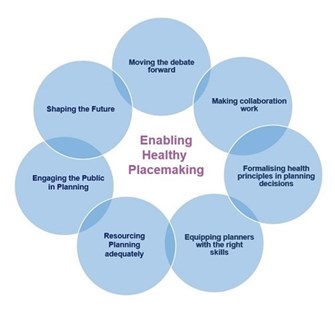 It is not the aim of this advice to place additional demands on planners in terms of responsibility for promoting mental health. The purpose of this advice is to highlight how good town planning can work to create the healthy places that are just one aspect of an overall contribution to supporting good mental health. It should be seen within the wider context of the health agenda, which needs to be delivered in a holistic and partnership way. The built environment can have an impact on how successfully an individual can embed healthy behaviours, such as social interaction and active travel, into their lives. By taking this approach to healthy behaviours and prevention it strengthens the arguments for a focus on healthy places to create good health now and in the future.
It is not the aim of this advice to place additional demands on planners in terms of responsibility for promoting mental health. The purpose of this advice is to highlight how good town planning can work to create the healthy places that are just one aspect of an overall contribution to supporting good mental health. It should be seen within the wider context of the health agenda, which needs to be delivered in a holistic and partnership way. The built environment can have an impact on how successfully an individual can embed healthy behaviours, such as social interaction and active travel, into their lives. By taking this approach to healthy behaviours and prevention it strengthens the arguments for a focus on healthy places to create good health now and in the future.
This approach builds on the RTPI research ‘Enabling Healthy Placemaking’[74] that highlights the need for cooperation and collaboration between planning, health and social care professionals and to ensure that health needs are integrated into the conceptualisation, design and planning stages of new developments. It highlights seven ways to enable planners to lead the way in creating healthy and sustainable communities, including communities that address mental health and well-being. These include focusing on effective implementation, making collaboration work through innovative partnerships, whilst continuing to engage the public in planning decisions.
4. What does a place designed to promote good mental health look like?
The Centre for Urban Design and Mental Health has developed the Mind the GAPS Framework[75] to consider the impact of urban places on mental health. It focuses on four key principles for designing places that effectively link all other policies together in a people centred model for health.
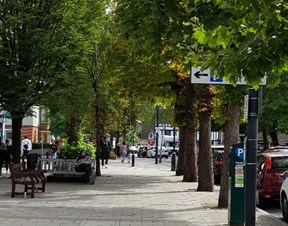 Green – access to natural settings in neighbourhoods and the course of people’s daily routines through public/private gardens, liveable streets and accessible and adaptable public spaces can improve and maintain mental health and wellbeing;
Green – access to natural settings in neighbourhoods and the course of people’s daily routines through public/private gardens, liveable streets and accessible and adaptable public spaces can improve and maintain mental health and wellbeing;
 Active – embedding opportunities for activity as part of day -to-day lives, with opportunities for exercise, social interactions, active travel and access to public transport can improve well-being, mental health and embed a sense of agency into daily routines;
Active – embedding opportunities for activity as part of day -to-day lives, with opportunities for exercise, social interactions, active travel and access to public transport can improve well-being, mental health and embed a sense of agency into daily routines;
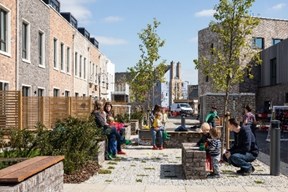 Pro-social – active co-production and stewardship of urban design that facilitates positive, safe and natural interactions among all people to promote an integrated sense of community, belonging and meaning;
Pro-social – active co-production and stewardship of urban design that facilitates positive, safe and natural interactions among all people to promote an integrated sense of community, belonging and meaning;
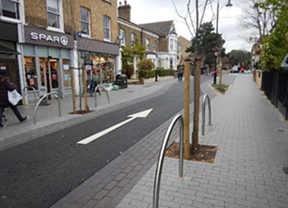 Safe – a sense of safety and security is integral to people’s mental health and well-being. Appropriate lighting and surveillance permeability, legibility, and people-centric design is important, plus high environmental quality and measures to reduce pollution, traffic and crime. A balanced approach is necessary, a safe environment improves accessibility, a risk-averse design can reduce action opportunities and people’s sense of agency and choice.
Safe – a sense of safety and security is integral to people’s mental health and well-being. Appropriate lighting and surveillance permeability, legibility, and people-centric design is important, plus high environmental quality and measures to reduce pollution, traffic and crime. A balanced approach is necessary, a safe environment improves accessibility, a risk-averse design can reduce action opportunities and people’s sense of agency and choice.
5. Planning for mental health
There are many opportunities for town planners to integrate consideration of mental health into their work. A policy, plan or development may not directly set out to address mental health issues, however by working to achieve other goals there can be indirect benefits. By taking an integrated approach from the start these benefits can be maximised.
With the use of a series of case studies, this section will highlight how consideration of environments designed for positive mental health can be achieved in a variety of ways. They include:
- Encouraging inclusive and connected communities;
- Creating a pedestrian friendly place;
- Introducing new greenspace;
- Protecting inner city access to greenspace;
- Refusing permission for isolated retirement housing;
- Restoring local pride;
- Temporary solutions to vacant sites.
Case study: Encouraging inclusive and connected communities - Old Mill Court, Sion Mills, County Tyrone
 Old Mill Court is a Rural Housing Association social housing scheme[76]. The scheme is comprised of 14 homes that combines innovative architectural design that is rooted in the history of its surroundings (Sion Mills village is famous for linen making and a conservation area), while also meeting the needs of residents. The first tenants moved in in December 2019. The scheme embodies the principles of the Rural Design Guide for Social Housing in Northern Ireland[77]. One of the aims of which is to re-image social housing, especially in rural areas. It is a Housing for All scheme. The scheme was set up to address segregation in social housing across the country. Due to the legacy of the troubles in Northern Ireland, the majority of social housing is divided along religious lines. Housing for All schemes aim to create mixed schemes where one religion does not exceed 70% of the total residents living in a scheme.
Old Mill Court is a Rural Housing Association social housing scheme[76]. The scheme is comprised of 14 homes that combines innovative architectural design that is rooted in the history of its surroundings (Sion Mills village is famous for linen making and a conservation area), while also meeting the needs of residents. The first tenants moved in in December 2019. The scheme embodies the principles of the Rural Design Guide for Social Housing in Northern Ireland[77]. One of the aims of which is to re-image social housing, especially in rural areas. It is a Housing for All scheme. The scheme was set up to address segregation in social housing across the country. Due to the legacy of the troubles in Northern Ireland, the majority of social housing is divided along religious lines. Housing for All schemes aim to create mixed schemes where one religion does not exceed 70% of the total residents living in a scheme.
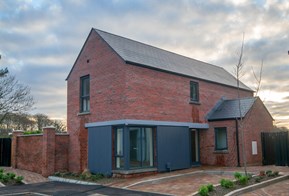 As a Housing for All scheme the Rural Housing Association is required to produce a comprehensive five-year good relations plan for the area. This will see the long-term delivery of a range of community focused initiatives for both the residents of Old Mill Court[78] and the wider community of Sion Mills, aimed at encouraging more inclusive and connected communities. Importantly the programme is tenant led. The space at Old Mill court is being utilised as a shared space for events. A steering group has been set up to guide the programme of activities to promote cultural diversity, along with positive health and mindfulness for the whole village. The positive approach to aftercare for integrating social housing tenants into the local area is something that can be replicated elsewhere.
As a Housing for All scheme the Rural Housing Association is required to produce a comprehensive five-year good relations plan for the area. This will see the long-term delivery of a range of community focused initiatives for both the residents of Old Mill Court[78] and the wider community of Sion Mills, aimed at encouraging more inclusive and connected communities. Importantly the programme is tenant led. The space at Old Mill court is being utilised as a shared space for events. A steering group has been set up to guide the programme of activities to promote cultural diversity, along with positive health and mindfulness for the whole village. The positive approach to aftercare for integrating social housing tenants into the local area is something that can be replicated elsewhere.
Case study: Creating a pedestrian friendly place - Orford Road, Walthamstow Village, London
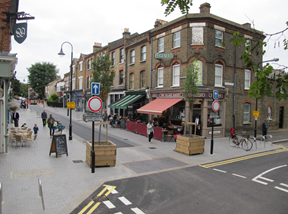 Walthamstow Village is located in the north east London Borough of Waltham Forest. As part of the wider Enjoy Waltham Forest[79] programme the area was selected to test out solutions to rat running by vehicles, deliver public realm enhancements, and improve safety and convenience for cyclists and pedestrians. The area is well located to enable many residents to travel by primarily sustainable modes. Walthamstow Central Underground and Overground station is a 10-minute walk from Orford Road, along quiet residential streets. To ensure mobility options are maximised, the W12 bus service, which travels through the area has been able to maintain its existing route along the otherwise pedestrianised main shopping street.
Walthamstow Village is located in the north east London Borough of Waltham Forest. As part of the wider Enjoy Waltham Forest[79] programme the area was selected to test out solutions to rat running by vehicles, deliver public realm enhancements, and improve safety and convenience for cyclists and pedestrians. The area is well located to enable many residents to travel by primarily sustainable modes. Walthamstow Central Underground and Overground station is a 10-minute walk from Orford Road, along quiet residential streets. To ensure mobility options are maximised, the W12 bus service, which travels through the area has been able to maintain its existing route along the otherwise pedestrianised main shopping street.
The project[80] began in 2014 with a pilot scheme that saw trial road closures for a two-week period to test the impact and community reactions. Through the pilot, the local authority learned that more community involvement at an earlier stage was required. To facilitate the input of as many interested parties as possible the design stage was enhanced with an on-line community engagement tool, Commonplace. This map-based platform enabled people to share their feelings, give reasons, and highlight locations where they think the street designs could be improved. Co-design workshops were also held with residents and businesses. The ability of the local community to design and plan the project was extremely important in ensuring ownership and making sure the end result was what people in the borough wanted.
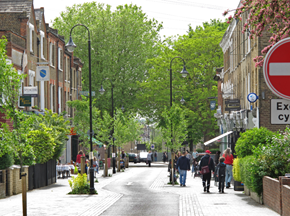 There has been a 77% reduction in traffic on Orford Road and neighbouring roads such as Copeland Road now have 97% less vehicle movements each day. Streets that were busy rat runs are quiet back streets once again with a much-improved balance of people walking, cycling and using public transport. The success of the scheme in reducing vehicles journeys whilst improving business footfall, has resulted in its principles becoming mainstreamed in schemes across the borough and beyond. The scheme initially met with vocal opposition by large parts of the community. However, the extensive community engagement has helped the local authority to work to continuously improve the scheme and to establish an innovative approach that can be replicated around the country at a time when there is a renewed focus on encouraging active travel and revitalising neighbourhood centres in light of the impact of Covid-19.
There has been a 77% reduction in traffic on Orford Road and neighbouring roads such as Copeland Road now have 97% less vehicle movements each day. Streets that were busy rat runs are quiet back streets once again with a much-improved balance of people walking, cycling and using public transport. The success of the scheme in reducing vehicles journeys whilst improving business footfall, has resulted in its principles becoming mainstreamed in schemes across the borough and beyond. The scheme initially met with vocal opposition by large parts of the community. However, the extensive community engagement has helped the local authority to work to continuously improve the scheme and to establish an innovative approach that can be replicated around the country at a time when there is a renewed focus on encouraging active travel and revitalising neighbourhood centres in light of the impact of Covid-19.
Case study: Introducing new greenspace - Grey to Green, Sheffield city centre
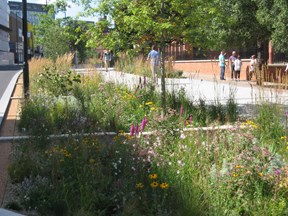 Sheffield’s Riverside Business District was an area dominated by a network of dual carriageways and complex junctions with a poor physical environment and connections. The Grey to Green project addressed poor quality of environment between the Riverside and core city centre and lack of social space serving the business and growing residential populations as identified in the ‘Breathing Spaces Strategy’ (2011). It has made the best use of redundant roadspace released by traffic diversion measures and as a result has encouraged more walking and cycling into and around the city centre. The proposals were presented to the council’s Access Liaison Group at an early stage to ensure the design was accessible to all. An extensive sustainable urban drainage system improves the area’s resilience to flooding and forms the attractive centrepiece of a scheme with rain gardens, gathering spaces, sculpture and generous footpaths that dramatically improves the quality of the local environment that has enabled a range of issues to be addressed in a single scheme[81].
Sheffield’s Riverside Business District was an area dominated by a network of dual carriageways and complex junctions with a poor physical environment and connections. The Grey to Green project addressed poor quality of environment between the Riverside and core city centre and lack of social space serving the business and growing residential populations as identified in the ‘Breathing Spaces Strategy’ (2011). It has made the best use of redundant roadspace released by traffic diversion measures and as a result has encouraged more walking and cycling into and around the city centre. The proposals were presented to the council’s Access Liaison Group at an early stage to ensure the design was accessible to all. An extensive sustainable urban drainage system improves the area’s resilience to flooding and forms the attractive centrepiece of a scheme with rain gardens, gathering spaces, sculpture and generous footpaths that dramatically improves the quality of the local environment that has enabled a range of issues to be addressed in a single scheme[81].
Case study: Protecting inner city access to greenspace - Tower Hamlets local plan policy
The Tower Hamlets Local Plan 2031: Managing Growth and Sharing Benefits[82] was adopted in January 2020. Tower Hamlets is one of the densely populated boroughs in the UK. It is a world-class hub for financial, technological and creative industries. The borough also has high population growth and high levels of deprivation. Health inequalities, physical activity levels and loneliness are all issues within the borough. As the borough becomes more densely populated, levels of open space deficiency are expected to increase. Improving existing open spaces and maximising opportunities to enhance the green grid and deliver small green interventions, such as pocket parks, as well as strategic open space will become increasingly important, especially within deficient areas.
The local plan includes policies to protect and improve public spaces. The plan protects all publicly accessible open space in the borough, allowing development only where a greater quantity and quality of open space is re-provided (Policy D.OWS3 Open space and green grid networks). A Green Grid Strategy[83] was developed to identify a network of routes and linkages that developments will be expected to enhance and connect. Blue space is also crucial in a borough with two rivers and numerous historic canals and docks, and the new local plan ensures that no more water space is lost to development, that access to water spaces is maintained, and that river walls and embankments are shored up as part of new development[84].
Case study: Refusing permission for isolated retirement housing - Catterall, Lancashire
In 2015, outline plans were submitted to Wyre Borough Council for a retirement village on farmland next to the Lancashire village of Catterall. The scheme was for 200 one and two-bed assisted-living units limited to residents aged over 55. The site plan showed on site provision of a bowling green, café/hall and green space, with the potential for the facilities to be open to the wider community. A minibus service was included as part of a local travel plan. The developer stated there were no sequentially preferable sites within the settlement boundary of Catterall. The local planning authority has identified a need for housing to meet the needs of the older population in the borough. The site is located on the edge of Catterall but separated from services and facilities by the A6, a busy high-speed commuter road with narrow footpaths and would not be conducive to ease of movement for pedestrians with mobility difficulties. There is no bus route running past the site. The nearest bus stop is 550m away, served by one bus route into a different nearby town.
The development was rejected at appeal, as it would “create an isolated enclave with limited opportunities for integration with the wider community”. The Inspector concluded[85] that whilst the location of services in the nearest local centre may comply with the walking distance identified in the Manual for Streets[86], the quality of the route to those services and facilities would be inadequate. Lack of detail about the funding, routes and eligibility of the minibus, raised concerns about its long-term provision, therefore not providing a meaningful alternative to the car. This example demonstrates that good planning can come from saying no. The benefits of the provision of older people’s housing would be outweighed by the disadvantages of an isolating, car dependent location that is unsafe for pedestrians.
Case study: Restoring local pride - Princes Avenue, Toxteth, Liverpool
 Princes Avenue in Toxeth, Liverpool was originally built as a tree-lined boulevard for the grand houses of the city’s merchant class. Since the wealthy residents moved out many years ago, the area has experienced high levels of deprivation, and for many has remained synonymous with the race riots that took place nearly 40 years ago.
Princes Avenue in Toxeth, Liverpool was originally built as a tree-lined boulevard for the grand houses of the city’s merchant class. Since the wealthy residents moved out many years ago, the area has experienced high levels of deprivation, and for many has remained synonymous with the race riots that took place nearly 40 years ago.
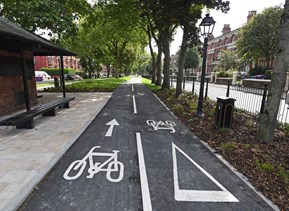 During 2020, the avenue was redeveloped in a £4 million scheme that aims to stimulate the wider regeneration of the area. The arts based redevelopment includes the transformation of the former Victorian boulevard into a reimagined event space, with artwork, tree and wildflower planting and a new 1km long cycle lane. Toucan crossings, carriageway surface, drainage and footway improvements have all been made. An important element of the scheme is an acknowledgement of the history of the area. William Huskisson was a Liverpool MP who defended the slave trade. His statue on Princes Avenue was removed during the riots, but the plinth on which it stood has been retained as part of the project and new inscription added. Other key features are the celebration of the area’s role in activism, music, faith and the historical diversity of the local community. This unique, community-led regeneration scheme led by Friends of Princes Avenue and Mandela8, and included over 150 local schoolchildren who helped to shape the design of public artwork, the granite paving and inscriptions, and interpretational signage. Culture Liverpool[87] led the creative engagement process. Pat Harvey, Chair of Friends of Princes Avenue, said; “Friends of Princes Avenue are proud of what we have achieved in the refurbishment scheme of our Boulevard. Our community came together and from this engagement process we have proven when councils listen, involve and respect communities amazing things can happen.”
During 2020, the avenue was redeveloped in a £4 million scheme that aims to stimulate the wider regeneration of the area. The arts based redevelopment includes the transformation of the former Victorian boulevard into a reimagined event space, with artwork, tree and wildflower planting and a new 1km long cycle lane. Toucan crossings, carriageway surface, drainage and footway improvements have all been made. An important element of the scheme is an acknowledgement of the history of the area. William Huskisson was a Liverpool MP who defended the slave trade. His statue on Princes Avenue was removed during the riots, but the plinth on which it stood has been retained as part of the project and new inscription added. Other key features are the celebration of the area’s role in activism, music, faith and the historical diversity of the local community. This unique, community-led regeneration scheme led by Friends of Princes Avenue and Mandela8, and included over 150 local schoolchildren who helped to shape the design of public artwork, the granite paving and inscriptions, and interpretational signage. Culture Liverpool[87] led the creative engagement process. Pat Harvey, Chair of Friends of Princes Avenue, said; “Friends of Princes Avenue are proud of what we have achieved in the refurbishment scheme of our Boulevard. Our community came together and from this engagement process we have proven when councils listen, involve and respect communities amazing things can happen.”
This project did not set out to address mental health issues. However, through extensive community involvement, addressing specific issues for the local area in a positive way through art, has led to a sense of pride in their home by participants contributing to wider health benefits.
Case study: Temporary solutions to vacant sites – Glasgow Stalled Spaces
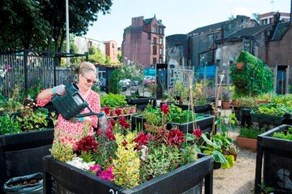 Stalled Spaces[88] is a Glasgow City Council programme to support community groups and local organisations develop temporary projects on stalled sites and vacant or derelict spaces as a community asset. These can take the form of growing spaces, pop-up gardens, wildlife areas, urban gyms or natural play spaces, temporary art, spaces for events or exhibitions or any other innovative idea. The emphasis is on meeting the needs of the community. In the first five years the project helped deliver over 100 projects bringing over 25ha of vacant, under utilised or stalled sites under temporary community use under the banner of ‘a community fit for a wee bit’. These temporary projects can deliver multiple gains. Including place-making and local regeneration, through enhancing the experience of a place and making an area safer and more attractive. By improving health and well-being through enhancing a community's access to green spaces and through community engagement by providing communities with an opportunity to work together as a team and contributing to social capital.
Stalled Spaces[88] is a Glasgow City Council programme to support community groups and local organisations develop temporary projects on stalled sites and vacant or derelict spaces as a community asset. These can take the form of growing spaces, pop-up gardens, wildlife areas, urban gyms or natural play spaces, temporary art, spaces for events or exhibitions or any other innovative idea. The emphasis is on meeting the needs of the community. In the first five years the project helped deliver over 100 projects bringing over 25ha of vacant, under utilised or stalled sites under temporary community use under the banner of ‘a community fit for a wee bit’. These temporary projects can deliver multiple gains. Including place-making and local regeneration, through enhancing the experience of a place and making an area safer and more attractive. By improving health and well-being through enhancing a community's access to green spaces and through community engagement by providing communities with an opportunity to work together as a team and contributing to social capital.
Research on the impact of the stalled spaces project found that 90% of participants felt their participation had a positive impact on their well-being, with 75% of people feeling that they had become more connected and active within their community. A participant in a scheme in a Kelvingrove Square scheme describes the impact as, “It has made a terrific difference to how many of us feel about living in the area.” It demonstrates how small-scale initiatives can have tangible well-being benefits in a very localised way. Architecture and Design Scotland have now expanded the scheme to other parts of Scotland and published a Stalled Spaces Scotland Toolkit[89].
6. Legislation and policy
Promoting health and well-being are key priorities for the planning systems in the UK and Ireland, although specific references to mental health are limited.
Equalities legislation
While national planning policy across the UK stresses the importance of physical health and well-being, but makes little direct reference to mental health. However, it is worth noting that where a policy refers to disability this can be taken to include mental health conditions as the definition of disability under the Equality Act 2010 refers to a physical or mental impairment that has a ‘substantial’ and ‘long-term’ negative effect on a someone’s ability to carry out normal daily activities. Authorities must also consider the implications of their duties under the Equality Act 2010, including the Public Sector Equality Duty. Disability is one of the nine protected characteristics under the Equality Act and the only characteristic where a duty of reasonable adjustment to buildings is required. In Northern Ireland there is a Disability Discrimination Act with similar legal protections and responsibilities for public authorities[90]. The Irish Human Rights and Equality Commission enforces the Public Sector Equality and Human Rights Duty under the Irish Human Rights and Equality Act 2014[91].
England
The National Planning Policy Framework (NPPF)[92] is organised around three core sustainable development objectives. The social objective, ‘to support strong, vibrant and healthy communities’, should support health, social and cultural well-being.
Section 8: Promoting Healthy and Safe Communities, states that planning policies and decisions should, ‘enable and support healthy lifestyles, especially where this would address identified local health and well-being needs’. The Framework acknowledges that access to a network of high quality open spaces and opportunities for sport and physical activity is important for the health and well-being of communities (para 96). It also states that planners should take into account and support the delivery of local strategies to improve health, social and cultural well-being for all sections of the community (para 92). The NPPF does include people with mental health needs within its definition of disability, but does not specifically mention mental health elsewhere.
The accompanying National Planning Policy Guidance (NPPG) again has little explicit mention of mental health. The key reference is in the description of a healthy place, one which “supports and promotes healthy behaviours and environments and a reduction in health inequalities… …provides It will provide the community with opportunities to improve their physical and mental health, and support community engagement and well-being’. The role of the need for social interaction is addressed, with further detail in the National Design Guide[93], which sets out ten characteristics of a well-designed place, including identity, built form, movement and public spaces.
The NPPG highlights the importance of engagement between plan making bodies and health organisations to ensure that health strategies and infrastructure are supported and considered in local plans. It identifies the Director of Public Health as the first point of contact on population health and well-being issues for planners. It states that they should be consulted on any planning applications that are likely to have a significant impact on the health and well-being of the local population, in order to work together on any necessary mitigation measures, using a health impact assessment where appropriate.
‘No Health without Mental Health’ is the mental health strategy for England. It identifies the need to reduce health inequality by tackling the inequalities that lead to poor mental health and the need to take into account people’s living environments and social circumstances, but without going into detail[94].
Wales
Planning Policy Wales 10[95] identifies key planning principles. These include, ‘facilitating accessible and healthy environments and ensure everyone can live, work, travel and play in a way that supports good physical and mental health.’ It goes on to say, ‘built and natural environments should be planned to promote mental and physical well-being.’
The Welsh Government’s Technical Advice Notes on planning do not contain specific references to mental health[96].
Planning policy in Wales is built on the strong foundations of the Well-being of Future Generations (Wales) Act 2015[97] through the seven interconnected, sustainable, well-being goals, including a healthier Wales and a Wales of cohesive communities. The Act requires public bodies to make sure that they take account of the impact they could have on people living in Wales in the future, including older people and people with disabilities. Local well-being plans[98] set out the Public Services Board’s priorities and actions to improve the economic, social, cultural and environmental well-being of each area in Wales. The plans could provide useful information for planning teams.
‘Together for mental health’[99] was published in 2012. It is the Welsh Government’s strategy to improve mental health and well-being. The strategy is integrated across all parts of government in Wales and highlights the importance of partnership working. Importantly it identifies a role for town planning and makes a direct link to Planning Policy Wales (pg21). It says, ‘the built environment and the surroundings that people live in can have an impact on people’s mental well-being. Ensuring there are good community facilities, people feel safe from crime, and are not living in noisy, overcrowded homes will be important. Planning Policy Wales is the policy framework for the effective preparation of local planning authorities’ development plans.’
Scotland
Planning (Scotland) Act 2019, states that one of the purposes of planning is to achieve the national outcomes[100]. The National Planning Framework 4 (NPF4) will need to align with the outcomes in the National Performance Framework, which includes that people grow up loved, safe and respected so that they realise their full potential and live in communities that are inclusive, empowered, resilient and safe and are healthy and active. The current National Planning Framework 3 (2014)[101] remains in place until NPF4 is adopted in 2021.
The national outcomes identify that health is dependent on a wide variety of factors and actors and that a whole system approach to promoting good health and activity is required. The indicators used to assess the outcomes include indicators relevant to mental health like loneliness and mental well-being and the environmental factors that are found to positively affect mental health like places to interact and access to green and blue space.
Mental Health Strategy 2017-2027[102] sets out the Scottish Government’s approach to mental health. It has the guiding ambition that, ‘we must prevent and treat mental health problems with the same commitment, passion and drive as we do with physical health problems.’ It identifies that environmental factors affect the prevalence and severity of mental illness, but does not establish a role for built environment professionals.
Northern Ireland
Improving health and well-being is one of the five core planning principles of the Strategic Planning Policy Statement for Northern Ireland[103]. It calls for local authorities to ‘contribute positively to health and well-being through safeguarding and facilitating quality open space, sport and outdoor recreation; providing for safe and secure age-friendly environments; and supporting the delivery of homes to meet the full range of housing needs, contributing to balanced communities’. It also ‘encourages planning authorities to engage with relevant bodies and agencies with health remits in order to understand and take account of health issues and the needs of local communities where appropriate’.
One of the stated aims of the Regional Development Strategy 2035[104] is to ‘promote development which improves the health and well-being of communities’ however there is little reference to health in the rest of the document.
Health and Well-being 2026: Delivering Together was a ten-year strategy and action plan for the transformation of Northern Ireland’s health and social care that was launched in 2016. The Department of Health published a mental health action plan in 2020 that included a commitment to produce a mental health strategy as a priority. Prevention and early intervention will be a key consideration, and the strategy will seek to bring together work being taken forward across government[105]. Protect Life 2 (2019-24), a long-term strategy to reduce suicides and self-harm, compliments this with action delivered across a range of government departments, agencies, and sectors launched in 2019 and updated in light of the Covid-19 pandemic[106].
Ireland
Project Ireland 2040: National Planning Framework[107] published 2018, takes a whole system approach to addressing health and well-being. It identifies that the specific health risks that can be influenced by spatial planning includes mental health. It states that by ‘addressing the many factors that impact on health and well-being and which contribute to health inequalities, and by empowering and enabling individuals and communities to make healthier choices, it will be possible to improve health outcomes.’ National Policy Objective 26 supports the objectives of public health policy, including Healthy Ireland and the National Physical Activity Plan, though the integration of these policies with planning policy.
The Healthy Ireland Framework[108] was launched in 2013 improve health and well-being. It proposes a shift towards a broader and more inclusive approach to ensure effective co-operation between the health sector and other areas of government and public services. It clearly expresses the importance of mental health as part of a healthy Ireland, highlighting that, ‘well-being also reflects the concept of positive mental health, in which a person can realise his or her own abilities, cope with the normal stresses of life, work productively and fruitfully, and be able to make a contribution to his or her community. The Framework includes 65 actions, one of which (3.10) is creating ‘activity friendly’ environments … that are appropriate to the needs of the community.’
7. Design of health and education facilities
The design of health and education facilities can have positive benefits for patients and students. In health facilities, therapeutic benefits can contribute to the speed and level of recovery. In educational settings, design elements can provide environments that are more conducive to learning by focusing on the well-being of students.
It is important that built environment professionals work collaboratively with health and educational professionals on the provision of facilities. A partnership approach means that planners and architects are able to better understand the patient or student experience and create spatial solutions that improve it. If health facilities are designed in a way that make patients feel less ‘institutionalised’ and more relaxed throughout the treatment process it can make them feel less isolated and worried about their condition, which translates into their recovery. Inviting places, with home comforts, quiet spaces, sensory rooms and access to natural light and view of greenspace all play a part. These factors are particularly important for patients receiving treatment for mental health conditions[109].
Children and young people spend a large part of their time in school and it is therefore a key place for shaping their well-being. The health and well-being of pupils contributes to their ability to benefit from good quality teaching and to achieve their full potential[110]. A school is a community, not just a building and the design of that building should reflect that sense of community and be inclusive for everyone within it. Spaces that recognise the importance of natural light, acoustics, good air quality, temperature and adequate, adaptable spaces, amongst other considerations will improve educational outcomes[111].
Case study: Therapeutic hospital design - Dumfries and Galloway Royal Infirmary
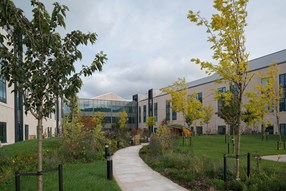 This 344-bed hospital is located on the outskirts of Dumfries. It was planned to maximise the rural setting by bringing the wider landscape into the site. This approach was taken because research has demonstrated that connections to nature results in positive health outcomes and faster healing times. The hospital has been designed around 17 courtyards and gardens, including a dedicated children’s garden in order to optimise views and natural daylight. There is even the opportunity for beds to be wheeled outside. The result is an uplifting, therapeutic and person centred environment.
This 344-bed hospital is located on the outskirts of Dumfries. It was planned to maximise the rural setting by bringing the wider landscape into the site. This approach was taken because research has demonstrated that connections to nature results in positive health outcomes and faster healing times. The hospital has been designed around 17 courtyards and gardens, including a dedicated children’s garden in order to optimise views and natural daylight. There is even the opportunity for beds to be wheeled outside. The result is an uplifting, therapeutic and person centred environment.
A strong partnership approach was employed throughout the project, with the NHS and the local authority working under a community planning partnership that involved key staff at all levels. A senior planning officer was embedded in weekly NHS project meetings from early in the pre-application stage. This resulted in the hospital being delivered within an extremely tight timescale, from conception in 2011 to completion in 2017.
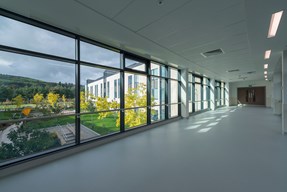 The building is designed to be accessible to all. Circulation routes include rest spaces for older and less able users and there are accessible therapeutic gardens. The internal circulation flows segregate visitors, staff/inpatients, and facilities management to avoid cross-flow clashes and improve infection prevention. As part of the NHS Scotland Design Assessment Process[112], a design statement was approved in consultation with Architecture & Design Scotland to act as a design control document. This process allowed the project to engage with the right stakeholders to inform the planning of the new facility and led to the design statement setting out a series of ‘non-negotiables’ for the design. These included accessibility for the population it serves, an inclusive and welcoming design, supporting patients’ sense of independence, and adaptability to future needs. Public health and healing times are expected to improve as a direct result of the innovative siting and design.
The building is designed to be accessible to all. Circulation routes include rest spaces for older and less able users and there are accessible therapeutic gardens. The internal circulation flows segregate visitors, staff/inpatients, and facilities management to avoid cross-flow clashes and improve infection prevention. As part of the NHS Scotland Design Assessment Process[112], a design statement was approved in consultation with Architecture & Design Scotland to act as a design control document. This process allowed the project to engage with the right stakeholders to inform the planning of the new facility and led to the design statement setting out a series of ‘non-negotiables’ for the design. These included accessibility for the population it serves, an inclusive and welcoming design, supporting patients’ sense of independence, and adaptability to future needs. Public health and healing times are expected to improve as a direct result of the innovative siting and design.
Case study: Removing clinical boundaries – James’ Place, Liverpool
 James’ Place is a suicide prevention charity that runs a male suicide therapy centre based in Liverpool that opened in 2018. It is the UK's first centre based outside a clinic or hospital to help suicidal men by providing counselling and therapy. The centre is based in an attractive four-storey town house in the centre of the city. Ellen O’Donoghue, the Chief Executive Officer explained that, “an important feature of the centre is that it is not a clinical environment. Time and money was spent on designing a homely and welcoming place to communicate to clients that this is somewhere that they can feel safe and looked after as soon as they arrive.” This careful attention to the building and garden translates into good clinical outcomes for clients, many of whom comment positively on the environment that has been created and say that they “felt at home” there. This contrasts with the experience many who attend the centre will have had in other settings, and clients will often arrive with negative pre-conceptions about the treatment and environment. This is important given that feelings of humiliation, anger, loneliness and rejection are all drivers for suicide that the therapists at the centre need to work with the clients to address.
James’ Place is a suicide prevention charity that runs a male suicide therapy centre based in Liverpool that opened in 2018. It is the UK's first centre based outside a clinic or hospital to help suicidal men by providing counselling and therapy. The centre is based in an attractive four-storey town house in the centre of the city. Ellen O’Donoghue, the Chief Executive Officer explained that, “an important feature of the centre is that it is not a clinical environment. Time and money was spent on designing a homely and welcoming place to communicate to clients that this is somewhere that they can feel safe and looked after as soon as they arrive.” This careful attention to the building and garden translates into good clinical outcomes for clients, many of whom comment positively on the environment that has been created and say that they “felt at home” there. This contrasts with the experience many who attend the centre will have had in other settings, and clients will often arrive with negative pre-conceptions about the treatment and environment. This is important given that feelings of humiliation, anger, loneliness and rejection are all drivers for suicide that the therapists at the centre need to work with the clients to address.
 Whilst acknowledging that the high quality design features of the centre did incur additional build costs the impact of the positive impact of the environment on clinical outcomes demonstrates that this approach can be replicated in other settings.
Whilst acknowledging that the high quality design features of the centre did incur additional build costs the impact of the positive impact of the environment on clinical outcomes demonstrates that this approach can be replicated in other settings.
Case study: Integrating mental health and education – Life Rooms at Hugh Baird College, Merseyside
 The St. Winefride’s Church project at Hugh Baird College in Bootle, Merseyside is a learning and social healthcare facility for use by students and local people. The Life Room integrates a former church and a new adjacent single storey building to provide a new mental health and well-being centre by refurbishing the interior spaces to create a modern and inspiring space. A large central space is defined by bespoke furniture and divided into zones, including the café, IT spaces, soft seating and a quiet reading area.
The St. Winefride’s Church project at Hugh Baird College in Bootle, Merseyside is a learning and social healthcare facility for use by students and local people. The Life Room integrates a former church and a new adjacent single storey building to provide a new mental health and well-being centre by refurbishing the interior spaces to create a modern and inspiring space. A large central space is defined by bespoke furniture and divided into zones, including the café, IT spaces, soft seating and a quiet reading area.
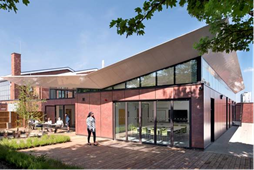 Life Rooms are a ‘community hub’ concept developed by Mersey Care NHS Foundation Trust that respond to mental distress, by providing a safe and welcoming environment for people who need support. There are four similar facilities across Liverpool. The Bootle Life Rooms offer a place where anybody from service users, carers, to students and local residents can access pathways advisors and obtain information about physical and mental well-being, money, housing, employment, education and recovery. They provide opportunities for volunteering, attending workshops and social prescribing. One of the benefits of integrating education and community care is that many students have been through the care system. Many students have also introduced family and friends to the Life Rooms.
Life Rooms are a ‘community hub’ concept developed by Mersey Care NHS Foundation Trust that respond to mental distress, by providing a safe and welcoming environment for people who need support. There are four similar facilities across Liverpool. The Bootle Life Rooms offer a place where anybody from service users, carers, to students and local residents can access pathways advisors and obtain information about physical and mental well-being, money, housing, employment, education and recovery. They provide opportunities for volunteering, attending workshops and social prescribing. One of the benefits of integrating education and community care is that many students have been through the care system. Many students have also introduced family and friends to the Life Rooms.
Full height glazing overlooks the wildflower garden and all rooms have doors leading out to external decks that give opportunity for learning, or as a contemplation space. This green outdoor space responds to the positive impact that biophilic design have on well-being.
This was a joint project between IBI Architects, Hugh Baird College and Mersey Care. Through collaboration on earlier joint Life Rooms, the partners had established a smooth stakeholder engagement process. The development was largely supported by the community and the success of existing Life Rooms meant that the proposals had local council backing from the outset. Tracey Merton, Architect and Mental Health Design Champion for the North of England and Scotland, who was involved in the project says, “The Life Rooms are making a meaningful difference to the well-being of the people of Bootle and the students at the college. There are over 3000 further education colleges in the UK. If just 1% were to enter collaborative relationships with local partners to offer services that broaden life choices in such neighbourhoods like Bootle, it would make a significant contribution to the nation’s health and well-being.”
Case study: Autism friendly design - Struan Centre for Autism, Stirling, Scotland
 New Struan School[113] is an independent day and residential school for autistic young people. The school includes seven classrooms, a multi-sensory room, splash area, library, early learning centre, staff room and an area for visiting therapists. It also houses an autism research centre, diagnostic and training centre and educational outreach services for schools across Scotland. The school was designed by a parent of a child with autism with input from the pupils and the expertise of staff who have observed how the physical environment can affect a child’s ability to learn and develop.
New Struan School[113] is an independent day and residential school for autistic young people. The school includes seven classrooms, a multi-sensory room, splash area, library, early learning centre, staff room and an area for visiting therapists. It also houses an autism research centre, diagnostic and training centre and educational outreach services for schools across Scotland. The school was designed by a parent of a child with autism with input from the pupils and the expertise of staff who have observed how the physical environment can affect a child’s ability to learn and develop.
 All the architectural features have an obvious purpose, whether that is to promote order and independent movement from one area to another or to offer predictability to enable the pupils to understand and anticipate the environment around them. The single story building is designed around one central walkway, the ‘street’, which runs the length of the building and provides a clear view of the whole school with independent movement from one area to the next. The street is wide, enabling groups of pupils to pass each other comfortably, without fear of collision or confusion. ‘Caves’ of learning curve outwards from the street, facilitating transitions by aiding the children in their visuo-spatial processing. Simple design features like the use of calm colour schemes, carpet to reduce noise, glass panels in doors so pupils have a view into the classroom before entering, curved walls to reduce sharp angles and obstructive corners all have a positive impact. The result is a safe, friendly and stimulating environment for autistic children and young people.
All the architectural features have an obvious purpose, whether that is to promote order and independent movement from one area to another or to offer predictability to enable the pupils to understand and anticipate the environment around them. The single story building is designed around one central walkway, the ‘street’, which runs the length of the building and provides a clear view of the whole school with independent movement from one area to the next. The street is wide, enabling groups of pupils to pass each other comfortably, without fear of collision or confusion. ‘Caves’ of learning curve outwards from the street, facilitating transitions by aiding the children in their visuo-spatial processing. Simple design features like the use of calm colour schemes, carpet to reduce noise, glass panels in doors so pupils have a view into the classroom before entering, curved walls to reduce sharp angles and obstructive corners all have a positive impact. The result is a safe, friendly and stimulating environment for autistic children and young people.
Struan School is considered an example of best practice in design for autism. Many elements can be incorporated into other schools and buildings to help them become more autism friendly.
8. Tools to integrate mental health into town planning
There are a number of approaches and tools that planners can use to make sure their plans, decisions and places work towards improving mental health. The right approach will depend on the circumstances, and while the RTPI does not recommend one approach over another, this chapter highlights some of the options available.
Mind the Gaps Framework
A framework[114] for planners and other built environment professional to consider the impact of urban places on mental health. It focuses on four key principles for designing places – green, active, prosocial and safe.
Impact of Vacant and Derelict Land on Communities
A toolkit from the Scottish Land Commission to help local authorities, decision makers, and communities measure and demonstrate the harm, including the health and well-being impacts, that derelict sites cause, helping to build a case for intervention. It includes a review of funding sources for the re-use of vacant and derelict land[115].
Livewell Development Accreditation
A voluntary accreditation scheme[116] that recognises the positive contribution that developers can play in improving health and well-being through their developments. It aims to raise health and well-being as a priority in new developments. The Essex Quality Review Panel makes a two-stage assessment against specially developed criteria (based on the Essex Design Guide and Essex Healthy Places Guidance) and if the proposal is shown to have the potential to make a positive contribution, the development is awarded a bronze, silver, gold, or highly commended award. Whilst the scheme currently operates in Essex, it is replicable across the UK and Ireland. It forms part of the broader Livewell campaign for the county[117].
Partnership working
Planners need to develop effective partnerships with public health and mental health care providers. These include social care; housing providers; health and well-being boards; NHS Trusts; and public health authorities. Health and well-being boards are responsible for encouraging integrated working on health and well-being issues, including the development of Joint Health and Well-being Strategies (JHWS), and Joint Strategic Needs Assessments (JSNA).
Health Impact Assessment
A health impact assessment (HIA) is a useful tool where there are expected to be significant health impacts of a development. When used proportionately HIAs can be explicit about identifying the health benefits and risks of a policy, plan or project. HIAs help to streamline the decision-making process based on shared goals of planners, public health professionals and the wider community.
Consultation tools
The Place Standard[118] is a tool developed by the Scottish Government, NHS Health Scotland and Architecture and Design Scotland. It is designed to help people talk about how they feel about their place in a methodical way. Local authorities use it as a framework for consultation on development.
9. Further information
Plan The World We Need – RTPI paper examining the contribution of planning to a sustainable, resilient and inclusive recovery - examines how planning can contribute to calls for a sustainable, resilient and inclusive recovery from the current health and economic crisis www.rtpi.org.uk/research/2020/june/plan-the-world-we-need
Enabling healthy placemaking – RTPI research paper on overcoming barriers and learning from best practices www.rtpi.org.uk/healthyplacemaking
Dementia and town planning – updated RTPI practice advice on creating better environments for people living with dementia www.rtpi.org.uk/dementia
Mind - a mental health charity in England and Wales. It advice, lobbies government and local authorities and raises public awareness www.mind.org.uk
Scottish Association for Mental Health - Scotland’s national mental health charity provides mental health social care support services www.samh.org.uk
Action Mental Health – mental health charity in Northern Ireland providing counselling, training and raising awareness www.amh.org.uk
Mental Health Ireland – mental health charity in Ireland that campaigns educates and provides support www.mentalhealthireland.ie
Centric Lab - neuroscience research and strategy lab focused on public health and the built environment www.thecentriclab.com
Centre for Urban Design and Mental Health - research and dialogue to build mental health into urban places, including Mind the GAPS www.urbandesignmentalhealth.com
What Works Wellbeing - collaborating centre that develops and shares robust and accessible wellbeing evidence to improve decision making https://whatworkswellbeing.org
[1] www.mind.org.uk/information-support/types-of-mental-health-problems/statistics-and-facts-about-mental-health/how-common-are-mental-health-problems/#HowCommonAreMentalHealthProblems
[2] https://ourworldindata.org/mental-health
[3] www.mind.org.uk/news-campaigns/campaigns/housing/
[6] www.publichealthwalesobservatory.wales.nhs.uk/mental-health
[7] www.gov.uk/government/publications/severe-mental-illness-smi-physical-health-inequalities/severe-mental-illness-and-physical-health-inequalities-briefing
[8] www.mind.org.uk/information-support/types-of-mental-health-problems/
[9] www.mind.org.uk/information-support/types-of-mental-health-problems/mental-health-problems-introduction/self-care/
[10] www.gov.uk/government/publications/no-health-without-mental-health-a-cross-government-outcomes-strategy
[11] www.england.nhs.uk/mental-health/adults/
[12] https://digital.nhs.uk/data-and-information/publications/statistical/adult-psychiatric-morbidity-survey/adult-psychiatric-morbidity-survey-survey-of-mental-health-and-wellbeing-england-2014
[13] https://gov.wales/sites/default/files/publications/2019-04/together-for-mental-health-summary.pdf
[14] www.gov.scot/policies/mental-health/
[15] www.health-ni.gov.uk/news/health-survey-northern-ireland-first-results-201415
[16] www.mentalhealth.org.uk/sites/default/files/FF16 Northern ireland.pdf
[17] www.gov.ie/en/policy-information/3aa528-mental-health/
[18] www.ons.gov.uk/peoplepopulationandcommunity/birthsdeathsandmarriages/deaths/bulletins/suicidesintheunitedkingdom/2019registrations
[19] www.assemblyresearchmatters.org/2019/11/28/suicide-statistics-and-strategy-in-northern-ireland-update/
[20] www.mentalhealth.org.uk/sites/default/files/FF16 Wales.pdf
[21] https://fingertips.phe.org.uk/profile-group/mental-health
[22] www.mentalhealth.org.uk/a-to-z/p/physical-health-and-mental-health
[23] https://researchbriefings.files.parliament.uk/documents/SN06988/SN06988.pdf
[24] www.campaigntoendloneliness.org/loneliness-research/
[25] www.rtpi.org.uk/practice/2020/september/dementia-and-town-planning/
[26] www.linkedin.com/groups/13908485/
[27] https://researchbriefings.files.parliament.uk/documents/SN06988/SN06988.pdf
[28] www.mind.org.uk/news-campaigns/campaigns/housing/
[29] https://gov.wales/sites/default/files/publications/2019-03/together-for-mental-health-a-strategy-for-mental-health-and-wellbeing-in-wales.pdf
[30] https://researchbriefings.files.parliament.uk/documents/SN06988/SN06988.pdf
[31] www.mentalhealth.org.uk/statistics/mental-health-statistics-children-and-young-people
[32] www.centreformentalhealth.org.uk/news/centre-mental-health-calls-government-set-budget-wellbeing-cost-mental-ill-health-england-reaches-ps119-billion
[33] www.fph.org.uk/policy-campaigns/special-interest-groups/special-interest-groups-list/public-mental-health-special-interest-group/better-mental-health-for-all/the-economic-case/the-costs-of-poor-mental-health/
[34] www.centreformentalhealth.org.uk/publications/mental-health-work-business-costs-ten-years
[35] www.mentalhealth.org.uk/statistics/mental-health-statistics-economic-and-social-costs
[36] Ibid
[37] www.oecd.org/health/health-at-a-glance-europe-23056088.htm
[38] https://fullfact.org/health/mental-health-spending-england/
[39] www.mind.org.uk/news-campaigns/news/nhs-figures-reveal-mental-health-spending-postcode-lottery/
[40] https://campaignresources.phe.gov.uk/resources/campaigns/82-every-mind-matters
[41] www.healthscotland.scot/news/2019/may/new-mental-health-and-suicide-prevention-resources-launched
[42] www.un.org/press/en/2020/sgsm20108.doc.htm
[43] www.centreformentalhealth.org.uk/publications/spending-review-wellbeing
[44] www.mind.org.uk/media-a/5929/the-mental-health-emergency_a4_final.pdf
[45] www.mentalhealth.org.uk/our-work/research/coronavirus-mental-health-pandemic/covid-19-inequality-briefing
[46] www.thecentriclab.com/covid-19-poverty-a-london-data-study
[47] www.ons.gov.uk/peoplepopulationandcommunity/birthsdeathsandmarriages/deaths/articles/coronavirusrelateddeathsbyethnicgroupenglandandwales/2march2020to10april2020
[48] www.rtpi.org.uk/news/plan-the-world-we-need/
[49] https://worldhappiness.report/
[50] www.ons.gov.uk/peoplepopulationandcommunity/wellbeing/bulletins/measuringnationalwellbeing/april2019tomarch2020
[52] www.mentalhealth.org.uk/blog/homelessness-and-mental-health
[53] http://england.shelter.org.uk/__data/assets/pdf_file/0005/1364063/Housing_and_mental_health_-_detailed_report.pdf
[54] www.ageuk.org.uk/information-advice/health-wellbeing/loneliness/
[55] www.ons.gov.uk/peoplepopulationandcommunity/housing/bulletins/housingaffordabilityinenglandandwales/2019
[56] www.ageing-better.org.uk/news/non-decent-homes-and-later-life-england-headline-statistics
[57] https://assets.publishing.service.gov.uk/government/uploads/system/uploads/attachment_data/file/902220/Research_report_quality_PDR_homes.pdf
[58] www.smartcitylab.com/blog/governance-finance/paris-15-minute-city/
[59] www.planning.vic.gov.au/policy-and-strategy/planning-for-melbourne/plan-melbourne/20-minute-neighbourhoods
[60] www.gov.scot/programme-for-government/
[62] www.highstreetstaskforce.org.uk/
[63] https://assets.publishing.service.gov.uk/government/uploads/system/uploads/attachment_data/file/904439/Improving_access_to_greenspace_2020_review.pdf
[64] http://fieldsintrust.org/green-space-index
[65] https://assets.publishing.service.gov.uk/government/uploads/system/uploads/attachment_data/file/355792/Briefing8_Green_spaces_health_inequalities.pdf
[66] www.greenspacescotland.org.uk/children#:~:text= Research shows the positive impacts that quality,attitudes to nature and the outdoors More
[67] www.gov.uk/government/groups/building-better-building-beautiful-commission
[68] https://landcommission.gov.scot/2019/10/derelict-sites-contribute-to-perceptions-of-urban-decline/
[69] https://landcommission.gov.scot/news-events/news-blog/re-use-derelict-land-to-support-economic-growth-and-wellbeing-says-taskforce
[70] www.urbandesignmentalhealth.com/journal-4---air-pollution-and-mental-health.html
[71] https://futurecities.catapult.org.uk/project/neuroscience-for-cities-a-playbook/
[72] www.rtpi.org.uk/research/2020/january/five-reasons-for-climate-justice-in-spatial-planning/
[73] www.gov.uk/research-for-development-outputs/fair-society-healthy-lives-the-marmot-review-strategic-review-of-health-inequalities-in-england-post-2010
[74] www.rtpi.org.uk/healthyplacemaking
[75] www.urbandesignmentalhealth.com/mind-the-gaps-framework.html
[76] https://ruralhousing.co.uk/culture-event-in-sion-mills/
[77] https://ruralhousing.co.uk/Rural-Design-Guide/
[78] Old Mill Court won RTPI Northern Ireland Award for Planning Excellence in 2020
[79] https://enjoywalthamforest.co.uk/
[80] Finalist in RTPI Awards for Planning Excellence 2018
[81] Finalist in RTPI Awards for Planning Excellence 2017
[82] www.towerhamlets.gov.uk/lgnl/planning_and_building_control/planning_policy_guidance/Local_plan/local_plan.aspx
[83] www.towerhamlets.gov.uk/Documents/Planning-and-building-control/Strategic-Planning/Local-Plan/Evidence-base/THGG-Final-Strategy-100511.pdf
[84] Winner in RTPI Awards for Planning Excellence 2020
[85] https://acp.planninginspectorate.gov.uk/ViewCase.aspx?Caseid=3215284&CoID=0
[86] https://assets.publishing.service.gov.uk/government/uploads/system/uploads/attachment_data/file/341513/pdfmanforstreets.pdf
[87] www.cultureliverpool.co.uk/princes-avenue/
[88] www.glasgow.gov.uk/stalledspaces
[89] www.ads.org.uk/stalled-spaces-scotland/
[90] www.equalityni.org/Legislation
[91] www.ihrec.ie/our-work/public-sector-duty/
[92] www.gov.uk/government/publications/national-planning-policy-framework--2
[93] www.gov.uk/government/publications/national-design-guide
[94] www.gov.uk/government/publications/the-mental-health-strategy-for-england 2011
[95] https://gov.wales/planning-policy-wales
[96] https://gov.wales/technical-advice-notes
[97] www.futuregenerations.wales/about-us/future-generations-act/
[98] https://naturalresources.wales/about-us/what-we-do/how-we-work/the-well-being-of-future-generations/?lang=en#:~:text=The local well-being plan sets out the Public,proposes to take to meet the well-being objectives
[99] https://gov.wales/together-mental-health-our-mental-health-strategy
[100] www.legislation.gov.uk/asp/2019/13/contents/enacted
[101] www.gov.scot/publications/national-planning-framework-3/
[102] www.gov.scot/publications/mental-health-strategy-2017-2027/
[103] www.planningni.gov.uk/index/policy/spps.htm
[104] www.infrastructure-ni.gov.uk/sites/default/files/publications/infrastructure/regional-development-strategy-2035.pdf
[105] www.health-ni.gov.uk/publications/mental-health-action-plan
[106] www.health-ni.gov.uk/sites/default/files/publications/health/actionplanataglance-may2020.pdf
[107] www.gov.ie/en/campaigns/09022006-project-ireland-2040/
[108] www.gov.ie/en/publication/e8f9b1-healthy-ireland-framework-2019-2025/
[109] www.psychologytoday.com/us/blog/designing-better-mental-health/202002/4-ways-design-can-improve-mental-health-care-spaces
[110] www.schooleducationgateway.eu/en/pub/latest/practices/well-being-ideas-for-healthie.htm
[111] www.architectsjournal.co.uk/archive/great-schools-the-importance-of-good-design
[112] www.ads.org.uk/healthier-places-guide-nhsscotland-design-assessment-process-ndap/
[113] www.scottishautism.org/new-struan-school/about/our-environment
[114] www.urbandesignmentalhealth.com/mind-the-gaps-framework.html
[115] https://landcommission.gov.scot/2019/10/derelict-sites-contribute-to-perceptions-of-urban-decline/
[116] www.essexdesignguide.co.uk/media/2275/eldp1024-livewell-accred-scheme-award-doc-a4-28pp-v7.pdf
[117] www.livewellcampaign.co.uk/
[118] https://placestandard.scot/


